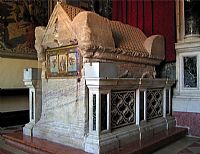
Euphemia was the daughter of a senator named Philophronos and his wife Theodosia in Chalcedon, located across the Bosporus from the city of Byzantium (which later became Constantinople, modern-day Istanbul). From her youth she was consecrated to virginity.
The governor of Chalcedon, Priscus, had made a decree that all of the inhabitants of the city take part in sacrifices to the pagan deity Ares. Euphemia was discovered with other Christians who were hiding in a house and worshipping the Christian God, in defiance of the governor's orders. They were tortured for a number of days, and then handed over to the Emperor for further torture. Euphemia, the youngest among them, was separated from her companions and subjected to particularly harsh torments, including the wheel, in hopes of breaking her spirit. It is believed that she died of wounds from a wild bear in the arena under emperor Diocletian (284-305).
Eventually, a magnificent cathedral was built in Chalcedon over her grave.
Around the year 620, in the wake of the conquest of Chalcedon by the Persians under Khosrau I in the year 617, the relics of Saint Euphema were transferred to Constantinople. There, during the persecutions of the Iconoclasts, her reliquary was said to have been thrown into the sea, from which it was recovered by the ship-owning brothers Sergius and Sergonos, who belonged to the Orthodox party, and who gave it over to the local bishop who hid them in a secret crypt. The relics were afterwards taken to the Island of Lemnos, and in 796 they were returned to Constantinople.
Her relics were later stolen by the Crusaders. The saint's head was taken by the Knights Templar to their preceptory in Nicosia on Cyprus. Today it is believed that the majority of her relics are kept inside Saint Euphemia's basilica in Rovinj, Croatia.
The legend says that during a stormy night the marble coffin containing the remains of the Saint disappeared fron Constantinople. Possibly fishermen who were believers loaded it onto their boats hoping that they could transport it to a safe place. In the same year (800) by a miracle it arrived at Rovinj in the sea. The local story says that the inhabitants tried tremendously hard all day using oxen and horses to remove the coffin from the sea. Finally, a young boy was able to achieve this with a pair of young untrained calves. Another version of the story says that it was a poor widow who moved the coffin.
The Rovinj skyline is difficult to imagine without the tall campanile of the church high above the town with its floodlit statue at the highest point, which appears to guard the roofs below. Throughout the passing centuries large numbers of worshippers came from all over Istra ( Istria ) to visit the coffin in which the Saint's body is preserved on St. Euphemia's Day, September 16th.
Source: cvergla blog, župa sv. eufemije rovinj, wikipedia